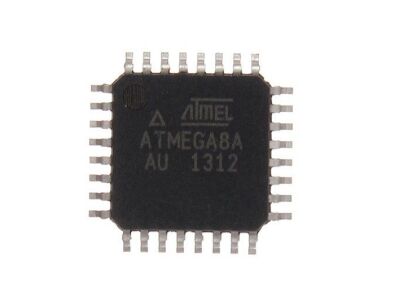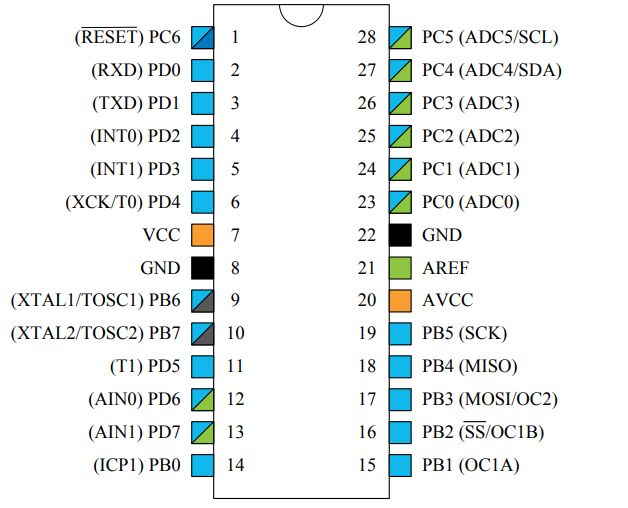By Microchip Technology / Atmel 155
ATMEGA8A-AU is a RISC-based 8-bit high-performance low-power AVR microcontroller, which combines 8kB ISP flash memory and read and write functions, 512B EEPROM, 1kB SRAM, 23 general-purpose I/O lines, 32 general-purpose working registers , three flexible timers/counters with compare mode, internal and external interrupts, serial programmable USART, byte-oriented two-wire serial interface, 6-channel 10-bit A/D converter with internal oscillator Programmable watchdog timer, SPI serial port and five software-selectable power-saving modes.

Ⅰ.Specification parameters of ATMEGA8A-AU
•Number of pins:32
•Core:AVR
•Products:MCUs
•Height:1.05 mm
•Length:7 mm
•Width:7 mm
•Program memory size:8 kB
•Data RAM size:1 kB
•Package/Case:TQFP-32
•RAM size:1K x 8
•ADC resolution:10 bit
•Data bus width:8 bit
•Supply voltage-Minimum:2.7 V
•Supply voltage-Max:5.5 V
•Installation style:SMD/SMT
•Humidity Sensitivity:Yes
•Minimum operating temperature:-40℃
•Maximum operating temperature:+85℃
•Data Ram type:SRAM
•Data ROM size:512 B
•Maximum clock frequency:16 MHz
•Processor series:megaAVR
•Number of input/output terminals:23 I/O
•Data Rom type:EEPROM
•Product category:8-bit microcontroller-MCU
•Number of timers/counters:3 Timer
•Product category:8-bit microcontroller-MCU
•Product type:8-bit Microcontrollers-MCU
Ⅱ.Features of ATMEGA8A-AU
•Peripheral Features
-Three PWM channels
-Real-time counter with separate oscillator
-8-channel ADC in TQFP and QFN/MLF package
-Two 8-bit timer/counters with separate prescaler, one compare mode
-One 16-bit timer/counter with separate prescaler, compare mode, and capture mode
•High Endurance Nonvolatile Memory segments
-512B EEPROM
-1 KB internal SRAM
-Data retention:20 years at 85°C/100 years at 25°C
-8 KB of In-System Self-programmable Flash program memory
•Advanced RISC Architecture
-Fully static operation
-On-chip 2-cycle multiplier
-Up to 16 MIPS throughput at 16 MHz
-130 powerful instructions - most single-clock cycle execution
•I/O and Packages
-23 programmable I/O lines
-28-lead PDIP, 32-lead TQFP, and 32-pad QFN/MLF
•Special Microcontroller Features
-Internal calibrated RC oscillator
-External and internal interrupt sources
-Power-on Reset and programmable Brown-out Detection
-Five sleep modes: Idle, ADC noise reduction, power-save, power-down, and standby
Ⅲ.Application fields of ATMEGA8A-AU
1.Automatic control system: ATMEGA8A-AU can be used to design various automatic control systems, such as temperature control, lighting control and robot control. In temperature control systems, ATMEGA8A-AU can be used to read data from temperature sensors, perform data processing and control decisions, and then drive actuators such as heating elements or fans to regulate the temperature of the system. In the lighting control system, ATMEGA8A-AU can be used to read the data of the photosensitive sensor and adjust the switch or brightness of curtains, lights and other equipment according to the light intensity to achieve the purpose of automatically adjusting indoor lighting. In the robot control system, ATMEGA8A-AU can be used to read sensor data, control motor drives, and implement functions such as navigation and obstacle avoidance.
2.Educational use: In educational environments, ATMEGA8A-AU is often used in various teaching projects and experiments, such as simple robot production, sensor data processing, and embedded system development. Such practice helps students gain a deeper understanding of basic concepts such as the working principle of microcontrollers, I/O interfaces, interrupt handling, timers/counters, etc.
3.Sensor interface: Due to its multiple communication interfaces (such as UART, SPI, I2C), ATMEGA8A-AU can be used to connect and control various sensors, such as temperature sensors, humidity sensors, accelerometers, etc.
4.Industrial control: ATMEGA8A-AU is widely used in small industrial control applications. Due to its powerful processing capabilities and flexible interfaces, ATMEGA8A-AU can be used to implement various control logic and monitoring functions. In small industrial automation systems, ATMEGA8A-AU can be used to control the movements of motors, valves and other actuators to realize automated operation of production lines. By reading input signals, such as limit switches, photoelectric sensors, etc., ATMEGA8A-AU can determine the position and status of the actuator, and then output corresponding control signals according to the preset control logic to drive the actuator to perform corresponding actions.
5.Embedded system: ATMEGA8A-AU is a microcontroller suitable for various embedded systems. Due to its low power consumption, high performance and rich peripheral interfaces, ATMEGA8A-AU can be used as the core control unit in embedded systems to complete various tasks and functions. It can be applied to various embedded systems, including home appliance control, smart home systems, embedded gateways, etc.
Ⅳ.Pin configuration of ATMEGA8A-AU

Ⅴ.Power consumption performance of ATMEGA8A-AU
1.Runtime power consumption: At runtime, the power consumption of ATMEGA8A-AU depends on the operating frequency, active peripherals, and complexity of code execution. In general, lower clock frequencies and efficient low-power programming can reduce runtime power consumption. The higher the operating frequency of ATMEGA8A-AU, the higher its power consumption is usually. Therefore, reducing the operating frequency is a common method to reduce runtime power consumption. If peripherals (such as UART, SPI, I2C, etc.) remain active when not needed, this will result in additional power consumption. Therefore, when writing code, you should minimize unnecessary peripheral activity or put peripherals into low-power states when they are inactive. The power consumption of the oscillator is also a factor to consider. If possible, use a low-power internal oscillator rather than an external oscillator because internal oscillators typically consume less current.
2.Clock switching: ATMEGA8A-AU supports clock cut-off mode, which is a very effective method to reduce power consumption. In clock cutoff mode, when most of the microcontroller's functions are inactive, the main clock can be turned off, thus significantly reducing power consumption. When the microcontroller needs to resume work, the main clock is turned back on to ensure normal operation. Since the microcontroller responds very quickly, there is little impact on real-time performance in clock cutout mode.
3.Sleep and power-saving modes: ATMEGA8A-AU provides a variety of power-saving modes, including Idle, Power-down, Standby, etc. These modes can effectively reduce power consumption, especially in low-power applications that require periodic wake-ups. In these modes, major clocks and peripherals can be turned off to reduce power consumption.
•Idle mode: In this mode, most of the clocks and peripherals of ATMEGA8A-AU are turned off, but the core CPU is still running and can quickly respond to external interrupts or events. The power consumption in this mode is relatively low, but still higher than in Power-down mode.
•Power-down mode: In this mode, the core clock of ATMEGA8A-AU is turned off, and only the RTC (real-time clock) and Watchdog timer are still running. In addition, some specific registers are maintained so that work can be quickly resumed upon wake-up. The power consumption in this mode is very low and is suitable for applications that require long periods of sleep.
•Standby mode: In this mode, almost all clocks and peripherals are turned off except RTC and Watchdog timer. The microcontroller is in its deepest sleep state and consumes very little power. However, wake-up may take longer because most of the hardware modules need to be reinitialized.
Ⅵ.Alternate model of ATMEGA8A-AU
•ATMEGA16A-AU
•ATMEGA48A-AU
•ATMEGA88A-AU
•ATMEGA328P-AU
Frequently Asked Questions
1.How long is the data retention time of the on-chip SRAM of ATMEGA8A-AU?
Normally, SRAM is a volatile memory, and its data retention time is short-lived. In microcontrollers, the data stored in SRAM is usually lost when power is cut off or lost, so SRAM is not suitable for long-term data storage.
2.What are the peripheral features of ATMEGA8A-AU?
The main peripheral features of ATMEGA8A-AU: GPIO, SPI, USART, timer/counter, TWI, EEPROM, ADC, low power mode, etc.
3.How much Flash memory and SRAM does ATMEGA8A-AU have?
ATMEGA8A-AU integrates 8KB of Flash memory, which is a non-volatile memory used to store program code, and it retains data even when the power is turned off. ATMEGA8A-AU integrates 1KB of SRAM. SRAM is a volatile memory used for temporary data storage. It is used to store data such as variables and intermediate calculation results during program execution.